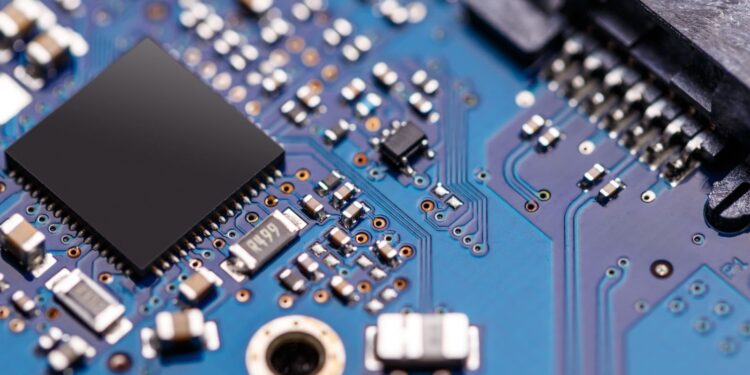Semiconductors are integral to our modern lives, and we use them more often than we realize. Here are a few ways in which we use semiconductors in everyday life:
ComputersSemiconductors are the building blocks of computer chips, which power everything from laptops and smartphones to gaming consoles and internet routers.
TransportationSemiconductors are used in anti-lock brakes, airbags, and fuel injection systems in cars, trains, and planes.
LightingLEDs (light-emitting diodes) use semiconductors to produce light more efficiently than traditional incandescent bulbs.
TelevisionSemiconductors power the circuits in televisions, including the ones that display the image you see on the screen.
Solar panelsSemiconductors are the primary component in solar panels, which convert sunlight into electricity.
Pro tip: Understanding the role of semiconductors in our everyday lives can help us appreciate the technology we use and inspire us to learn more about how it works.
Introduction to Semiconductors
Semiconductors are essential for modern electronics and have become integral to everyday life. They are used in every device from smartphones to computers and car engines to digital signs.
This article will discuss what semiconductors are and how we use them daily.
What are Semiconductors?
Semiconductors are materials that have a conductivity level between conductors and insulators. These materials can conduct electricity under certain circumstances and are essential components in electronic devices we use daily.
Semiconductors are used in the following ways in our everyday life:
1) Integrated Circuits(ICs) comprise numerous semiconductor components like diodes, transistors, and microprocessors and are used in smartphones, computers, and other digital devices.
2) Solar Panels Semiconductors convert sunlight into electricity in solar panels.
3) Light Emitting Diodes(LEDs) When electricity passes through semiconductors in LEDs, it emits light, making them useful as indicator lights in electronic devices and lighting.
4) Sensors Accelerometers, proximity sensors, and GPS all use semiconductors to function.
Without semiconductors, our world of electronics and connectivity would not have been possible.
Types of Semiconductors
Semiconductors are materials that have the unique property of partially conducting electricity. There are two types of semiconductors – intrinsic and extrinsic.
Intrinsic semiconductors are pure semiconducting materials, such as silicon (Si), germanium (Ge), and diamond (C). These materials become partially conductive when heated or exposed to light.
Extrinsic semiconductors are doped with foreign atoms to alter their conductivity. This includes n-type semiconductors, which are doped with elements such as phosphorus (P) or arsenic (As) to increase electron concentration; and p-type semiconductors, which are doped with elements such as boron (B) or aluminum (Al) to increase hole concentration.
The use of semiconductors is integral to many technologies in our everyday lives. For example, from smartphones to televisions and even solar panels, semiconductors allow us to harness the power of electricity in efficient and practical ways.
Properties of Semiconductors
Semiconductors have electrical conductivity between conductors (like metals) and non-conductors (like insulators). This unique property makes semiconductors ideal for a wide range of applications in everyday life.
Here are some common examples of how we use semiconductors in our daily lives:
ElectronicsFrom smartphones to computers, semiconductors are an essential component of electronic devices. In addition, integrated circuits made of semiconductors help power and control electronic devices.
Solar PanelsSemiconductors like silicon are used in solar panels to convert sunlight into electricity, making clean energy accessible to everyone.
LED LightsLight Emitting Diodes or LEDs, are built using semiconductors that emit light when electricity passes through them. This technology has revolutionized the lighting industry by offering energy efficient and long-lasting light sources.
TransistorsThese small semiconductor devices act as switches or amplifiers, controlling the flow of electrical currents in electronic devices. They’re used in every electronic device, from televisions to medical equipment.
Pro Tip: Semiconductors have many properties that make them incredibly useful. In addition to their electrical conductivity, they can also be used to control light and heat.

費城半導體
Semiconductors are essential components used in our daily lives. From powering our smartphones, to being used in medical devices and even everyday appliances, semiconductors have a wide range of applications.
In this article, we look at the various ways in which semiconductors are used in our everyday lives and how they enable many of the devices and technologies we take for granted.
Smartphones and Computers
Semiconductors play an important role in the ubiquitous technologies we use every day. For example, smartphones and computers contain semiconductors, which power their capabilities.
Smartphones rely on semiconductors to perform numerous functions, including communication, data storage, and graphics rendering. These technologies have evolved, and smartphones today boast powerful processors like Apple’s A14 Bionic chip, which contains more than 11.8 billion transistors on a single chip.
Computers also depend on semiconductors, from storing information to performing complex simulations.
All modern computers have microprocessors, and the leading microprocessor manufacturers, Intel and AMD, produce chips with billions of transistors that can perform billions of calculations per second.
In summary, semiconductors are the backbone of the planet’s most widely used electronic devices, making them an essential component of modern life.
Television and Radio
Television and radio are two common examples of using semiconductors in everyday life. For example, semiconductors are essential components of the electronic circuits that power TVs and radios. Due to its abundance and unique electronic properties, Silicon is the most commonly used semiconductor material.
In TVs, semiconductors are used as transistors, which act as switches to control the flow of electrical current. For example, TV tuners use transistors to select different channels and in the display screen to create images.
In radios, semiconductors are used as diodes, allowing electrical current to flow in one direction only. In addition, diodes are used in radio receivers to detect and demodulate radio signals.
Overall, semiconductors are essential to the functioning of modern electronic devices, making TV and radio just a couple of examples of how integral these technologies are to our daily lives.
Transportation Systems
Semiconductors are crucial in modern transportation systems, making them more efficient, safer, and convenient.
Here are some ways semiconductors are used in transportation:
- Traffic control systems use semiconductors to power traffic lights, sensors, and other devices that monitor traffic flow and congestion.
- Advanced driver assistance systems (ADAS) rely on semiconductors to provide real-time data about road conditions, weather, and other factors to help drivers navigate safely.
- Electric vehicles use semiconductors to regulate power and improve battery efficiency, leading to longer range and faster charging times.
- Hybrid vehicles use semiconductors to manage the flow of electricity between the battery, motor, and engine, maximizing fuel efficiency.
- Aircraft and spacecraft use semiconductors in their navigation, communication, and control systems, ensuring safety and reliability in extreme conditions.
These applications show how semiconductors have revolutionized transportation systems and have made our daily commutes faster, safer and more comfortable.
Renewable Energy
Semiconductors are critical components of renewable energy sources, including solar panels and wind turbines, making sustainable power generation possible. Additionally, semiconductors have many applications in everyday life, from electronics to transportation to healthcare. Here are some examples:
Semiconductors are key components of electronic devices, including smartphones, computers, and televisions. They are used in microprocessors, memory chips, and sensors, among other things. Modern automobiles rely heavily on semiconductors, such as engine control, safety, and entertainment systems. Electric and hybrid vehicles also require semiconductors for their power electronics. In addition, semiconductors play a crucial role in medical imaging, such as X-rays and MRIs. They are used to produce high-quality images while minimizing radiation exposure.
In conclusion, semiconductors have revolutionized the way we live our lives and will continue to do so in the future. They are central to renewable energy and have countless applications in everyday life.
Medical Devices
Like many everyday products, medical devices rely on semiconductors for their operation. Semiconductors are a crucial component in devices like pacemakers, glucose monitors, and imaging machines, where their ability to control the flow of electricity is essential.
Here are some examples of how semiconductors are used in medical devices:
Pacemakers
Use semiconductors to generate the electrical signals that regulate the heartbeat.
Glucose monitors
Use semiconductors to convert the chemical reactions between glucose and other substances into an electrical signal that can be read and displayed.
Imaging machines
Use semiconductors to create magnetic fields to produce detailed images of the body’s internal structures.
Semiconductors have revolutionized the field of medical technology, enabling the development of faster, more accurate, and more effective devices essential to patient care.

Future of Semiconductors
Semiconductors are becoming increasingly important in our modern world and the future of semiconductors is bright. From their use in computers to their ability to store and process vast amounts of data, semiconductors play a crucial role in our day-to-day lives.
In this article, we will explore the future of semiconductors and how they will continue to impact our everyday lives.
Advancements in Miniaturization
Advancements in miniaturization have revolutionized the semiconductor industry and are paving the way for smaller, faster, and more efficient technologies we use daily.
Some of the most significant advancements in miniaturization include:
1. Shrinking the size of transistors:
The constant reduction in transistor size has led to smaller and more energy-efficient electronic devices.
2. Use of Nanotechnology:
The use of nanotechnology has enabled the creation of tiny components, eventually leading to the development of powerful and miniature electronic devices.
3. Development of advanced manufacturing techniques:
Advanced manufacturing techniques, such as 3D printing, have significantly transformed how semiconductors are produced, leading to higher efficiency and yield of the final product.
These advancements in miniaturization will continue to shape how we use semiconductors in everyday life, enabling innovations such as wearable smart devices, IoT, and autonomous machines.
Potential for Energy Efficiency
The potential for energy efficiency using semiconductors is enormous and growing every day. In our daily lives, from the computers and smartphones we use to communicate, to the cars we drive, semiconductors are the fundamental building block that enable these technologies to function with energy efficiency.
The possible applications for the use of semiconductors in energy efficiency are vast. These include energy-efficient lighting, renewable energy, smart grids, and more. One of the most promising opportunities for energy efficiency using semiconductors is in power electronics. These technologies can reduce the energy loss that occurs during electrical power conversion.
With the continued advancement of semiconductor materials and technologies, the future of energy efficiency looks brighter than ever.
Impact on the Economy and Job Market
The semiconductor industry significantly impacts the economy and job market, as semiconductors are essential components in nearly every electronic device we use daily, including computers, smartphones, and even cars.
The future of semiconductors is promising, as the demand for advanced electronics continues to grow.
Here are some ways semiconductors impact the economy and job market:
1. Job creation: Semiconductor companies employ thousands of people worldwide, from engineers to technicians.
2. Economic growth: The semiconductor industry generates billions of dollars in revenue and contributes to countries’ overall economic growth worldwide.
3. Innovation: Semiconductors are driving technological innovation, enabling the development of new products and services that improve our quality of life.
As the demand for electronics rises, the semiconductor industry will continue to grow, creating job opportunities and driving economic growth.

Challenges and Limitations of Semiconductors
Semiconductors are widely used in various everyday applications and products but also present certain challenges and limitations. This article will look at the challenges and limitations of semiconductors and how they impact everyday life.
Some key issues related to the use of semiconductors, such as power consumption and heat dissipation, need to be addressed to make their use more effective. We will discuss these challenges and limitations in the following paragraphs.
Environmental Concerns
Semiconductors are integral to our daily lives, powering many electronic devices such as smartphones, computers, and televisions. However, some environmental concerns arise with the use of semiconductors in such a large scale.
One challenge is the manufacturing process itself, which requires a significant amount of energy and water consumption. Additionally, producing semiconductors generates hazardous waste that must be disposed of properly to avoid harming the environment.
Another limitation is the short lifespan of semiconductor devices, resulting in the need for frequent upgrades and replacements. This creates a large amount of electronic waste that is often not recycled properly and can end up in landfills or the ocean, polluting the environment.
While semiconductors have revolutionized how we live and work, addressing these environmental concerns and working towards more sustainable manufacturing and disposal practices is important.
Pro Tip: Consider properly disposing of electronic waste at a certified recycling center to reduce environmental harm.
Technological Limitations
Semiconductors have revolutionized how we live our lives, from electronics to transportation. However, technological limitations challenge the semiconductor industry and can hinder its progress.
Here are some of the challenges and limitations of semiconductors:
As transistors become smaller and more powerful, they generate more heat, which can damage the device and impair its performance. Heat dissipation is a major challenge in designing and manufacturing semiconductors. Semiconductors can be energy-efficient, but they still consume a significant amount of power. Improving energy efficiency without sacrificing performance is a key technological challenge. In addition, as semiconductors become more complex, the design and fabrication process becomes more challenging and expensive. This limits the ability to make low-cost, high-performance devices for everyday use.
Pro tip: Despite these challenges, the semiconductor industry continues to innovate and push the limits of technology, driving progress and improving our quality of life.
Cost and Accessibility Issues
Semiconductors have revolutionized everyday life with their superior electronic properties. However, cost and accessibility challenges still plague the semiconductor industry.
One of the main challenges is the high cost of producing semiconductors, particularly the ones used in advanced technologies like microprocessors and sensors. This is due to the complex manufacturing process involving expensive equipment and facilities.
Another challenge is the accessibility of semiconductors in certain regions, particularly in developing countries. The lack of access to these technologies hinders the growth and development of these economies.
To address these challenges, governments, research institutions, and private industries must collaborate to develop cost-effective manufacturing techniques and improve accessibility to these technologies.
Pro tip: Insourcing semiconductor manufacturing can be a cost-effective alternative for companies to control their supply chain and scale their operations.
Conclusion
Semiconductors are an integral part of our lives and appear in many facets of our everyday lives. They provide us with communication, entertainment, and countless other technologies. In addition, semiconductors are used in various devices including smartphones, tablets, computers, and other electronic devices.
By understanding the role of semiconductors in everyday life, we can understand their importance and the opportunities they provide.
Summary of Key Points
Semiconductors are integral to modern technology and are used in various applications like telecommunications, computing, and energy management. From our smartphones to laptops, and even our cars, semiconductors play a significant role in our daily lives.
Some of the key points to keep in mind regarding the use of semiconductors in everyday life are-
- Semiconductors can be found in electronic devices like transistors, diodes, and solar cells.
- The size of semiconductors continues to shrink, making electronic devices more compact and energy-efficient.
- Semiconductors also help to manage energy consumption better, keeping our homes and offices cool.
- The semiconductor industry continues to grow, and innovations are made almost daily.
Overall, semiconductors have revolutionized how we live, work and communicate.
Final Thoughts on Semiconductors’ Role in Everyday Life
In conclusion, semiconductors play a vital role in our daily lives, powering everything from smartphones and laptops to cars and medical equipment. Credited with revolutionizing the field of electronics, semiconductors have made it possible to create faster, smaller, and more energy-efficient devices. In addition, their unique properties, such as conductivity and non-linearity, paved the way for numerous innovations in our modern world. From analog to digital, semiconductor technology has progressed at a staggering pace, allowing us to enjoy unprecedented convenience, speed, and connectivity. Yet, it’s safe to say that our lives would be drastically different without semiconductors.
We look forward to new advancements in this field that will continue to shape our future.
Pro Tip: When shopping for electronics, check the device’s processor and memory specifications, which are powered by semiconductors, to ensure you get the best performance.
















